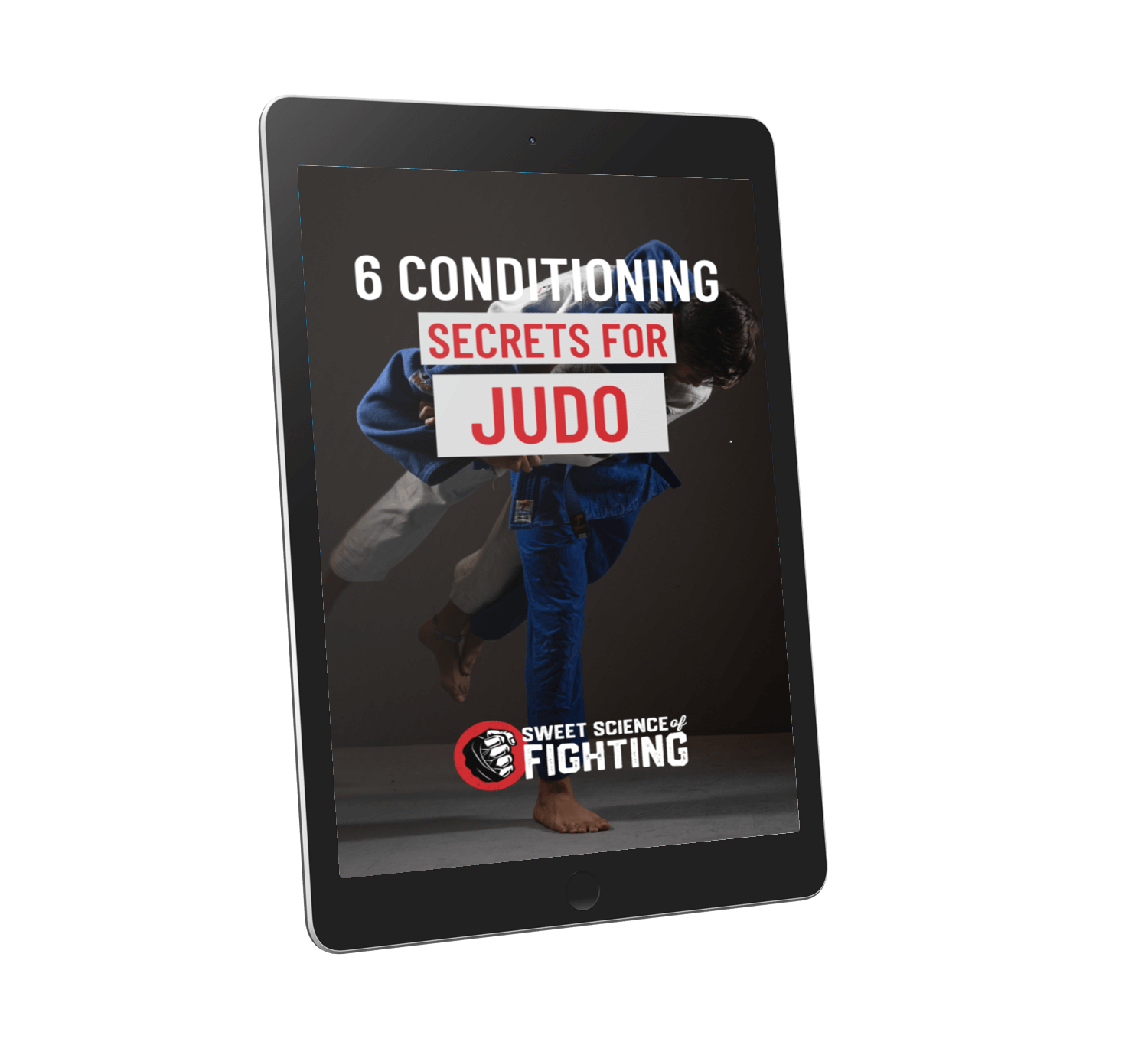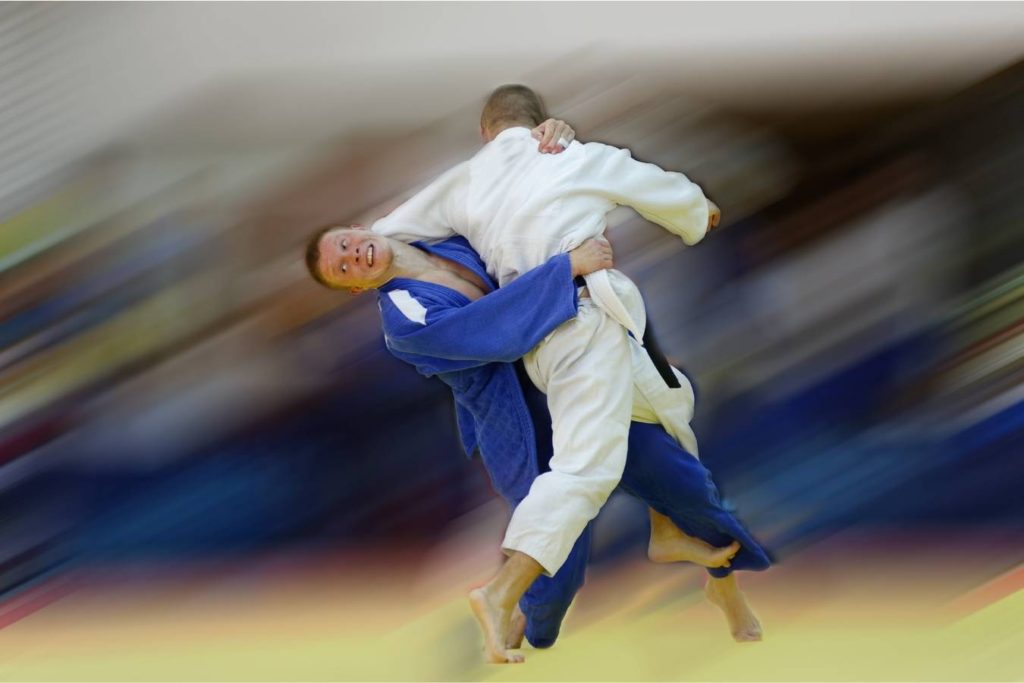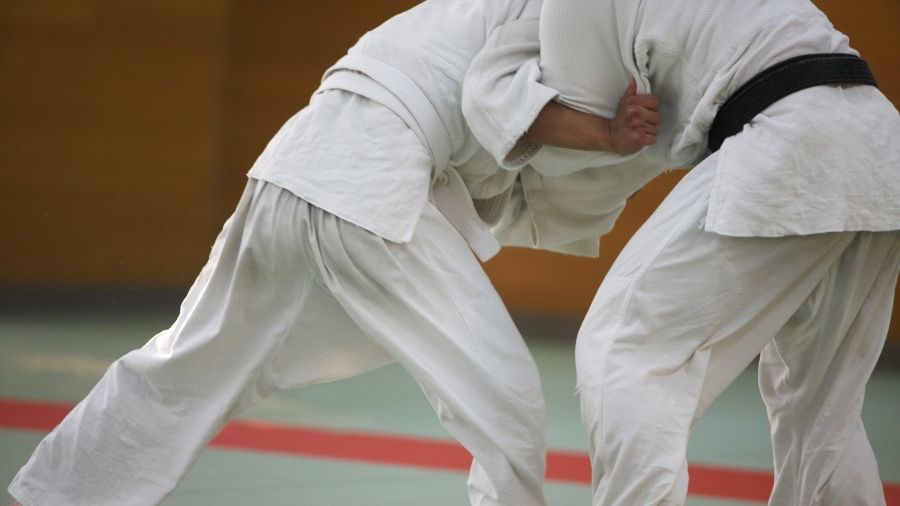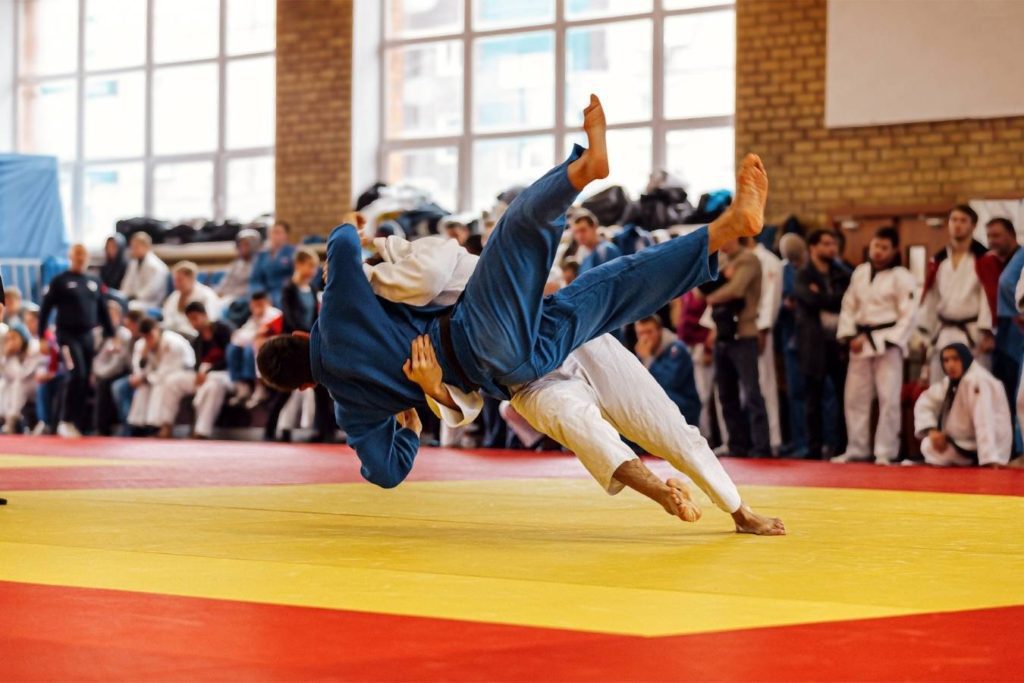Judo is an intermittent sport that requires a high level of upper limb muscle and upper body anaerobic power and capacity.
Conditioning for Judo requires developing a high-level anaerobic lactic energy system after a strong aerobic base has been built. Performing conditioning using throwing techniques is the best way to transfer conditioning to Judo performance.
Now, not all of your training should be performed on the mats. It would be sub-optimal to try to develop the aerobic energy system using throwing techniques. Not to mention the high level of monotony in training which can lead to overuse injury.
But before diving into how to condition for Judo, we must know the requirements of a Judoka within a competitive match and how the elite Judoka differs from a non-elite Judoka.
Match Demands Of Judo
When breaking down the match demands of Judo, we need to classify actions in a match.

Unlock The Secrets To Elite Judo Strength & Conditioning With Our FREE eBook
- In-activity or Break – pause in the match [3].
- Preparation – phase of preparation for grip disputes [3].
- Grip dispute – this involves fighting to secure grips in order to execute a throwing technique. In fact, approximately 50% of active match time is spent in grip dispute [1].
- Technique (nage-waza) – the execution of a throwing technique [2].
- Groundwork (ne-waza) – technical actions on the ground [2].
Judo matches are 5 minutes in length unless there is a draw in which a no-limit extra time period takes place until an athlete scores a point.
Regardless of the level of competition, Judo matches last approximately 3 minutes [2]. Activity in a match varies from 10-63 sec (grip disputes, throwing techniques, and groundwork) with periods of inactivity from 1-22 sec.
As the match goes on, periods of activity go from longer to shorter while in-activity goes from shorter to longer.
The activity-pause ratio generally sits at 2:1 or 3:1. This can be broken down further into how the activity period is spent in a match.
The preparation period lasts approximately 4 seconds (2-6 sec range), grip disputes last 16-18 seconds (11-21 sec range), throw attacks last 1-1.7 seconds (0.6-2.2 sec range), and groundwork lasts 9-17 seconds (5-29 sec range) [3].
Grip disputes represent approximately 50% of the total activity time making grip strength and endurance an important factor to Judo success.
The reason I present the time ranges alongside the average activity periods is that averages don’t provide the bigger picture. If you solely used averages to base your training on, you would not optimize your Judo preparation as you would not be prepared for activity periods that exceed the average or break periods that fall short of the average.
Now that we understand how a Judo match is broken down regarding activity and in-activity, we must observe what differentiates an elite Judoka from a non-elite Judoka.
Elite vs. Non Elite Judokas

When comparing Judokas who participated at Olympic or Asian Games (elite) versus Judokas at a university who won top 8 in intercollegiate competition (competitive) or university Judokas that don’t compete (non-elite), the upper arms and forearms were significantly larger in the elite Judokas compared to the non-elite.
Fat-free mass (muscle, bone) was significantly larger in elite vs. non-elite and tended to be larger than competitive Judokas but wasn’t significant. There were no other differences in muscle thickness around the body [4].
Another study found similar findings where Brazilian National and International Medalists (elite) were compared to Brazilian non-medalists at Brazilian National tournaments [5]. They found there was no difference in skinfold thickness between elites and non-elites but elite Judokas had thicker upper arms, forearms, wrists, and calves.
Elite and non-elite Judokas displayed similar handgrip isometric strength. However, elite Judokas showed greater mean and peak power relative to body weight during an upper-body anaerobic power and capacity test. Interestingly, there were no differences in the time to reach peak power or in fatigue.
During the Special Judo Fitness Test (SJFT), elite Judokas performed a greater number of throws than non-elites. If you are not familiar with the SJFT, the video below demonstrates it. There are 6 m between the two ‘human dummies.’
There are 3 periods. The first period lasts 15 seconds, periods 2 and 3 last 30 seconds. The goal is to make as many throws as possible [6].
Aerobic capacity did not differ between elite and non-elite Judokas.
So what makes elite Judokas elite? We know that an elite level Judoka has greater upper limb muscle thickness but not necessarily a stronger grip, the ability to generate greater anaerobic power in the upper body, and greater anaerobic capacity while throwing.
Aerobic capacity, while important, doesn’t seem to differ between elite and non-elite Judokas as it seems even non-elite Judokas have well-developed aerobic energy systems at the national level.
However, the aerobic energy systems seem to play the largest role in energy contribution over full 5-minute simulated matches where aerobic energy contribution rises from 50% to 81% throughout the match [11].
If we take a look into the technical side of Judo, one study compared super-elite to elite Judokas [7]. Super elites were the most successful Judokas at four consecutive World Championships and two consecutive Olympic Games. This was calculated by creating a points criteria of:
- 5 points for a Gold medal
- 3 points for a Silver medal
- 1 point for a Bronze medal
Elites participated in the same competitions and were top 7 at least twice, but not the champion in any event.
The two main factors that differentiated these groups were the Super elites performed a greater number of throwing techniques AND performed more throwing techniques in different directions than the elite group.
Why is this important? Because data like this can be used in your own conditioning training.
Conditioning Requirements For Judo

Aerobic Capacity For Judo
While aerobic capacity doesn’t differentiate elite or non-elite Judokas, if you don’t have a well-developed aerobic energy system, you will suffer between activity periods and matches.
We know from my article “What Is Conditioning Training” that the aerobic energy system is the most trainable and directly influences how quickly you can recover between high-intensity efforts such as throws.
Developing aerobic capacity for judo should have an upper body focus. These are the modes of exercise that I believe would provide a good aerobic foundation for Judo away from the mats:
- Arm ergometer
- Ski ergometer
- Medicine ball circuits
- Airdyne to a lesser extent
You can hear how Dutch Olympic Judo Strength & Conditioning Coach Casper de Wit prepares his elite Judoka on our podcast below:
As the upper body is so important to Judo, aerobic base training should reflect that. Here are some aerobic training options based on these modalities.
Option 1 (Cardiac Output)
30-60 minutes of continuous, steady-state work keeping heart rate between 130-150 BPM and no higher.
Option 2 (Cardiac Power)
60 sec maximum effort with heart rate recovery between 120-130 BPM.
Option 3 (Tempo Training)
20-40 seconds @70% effort/pace with 20-40 seconds rest. Up to 40 minutes of total work.
Lactic Power and Capacity For Judo
This is where, unlike conditioning for BJJ, lactic power and capacity can be trained directly by the sport. Since Judo success seems to be highly influenced by the anaerobic energy system, this makes a perfect combination of drilling skills and conditioning at the same time.
Developing anaerobic lactic capacity and power will allow a greater number of throws to be performed in a match with similar effort and intent.
These simple guidelines can be used for developing lactic power and capacity:
Option 1 (Lactic Power)
20-30 seconds maximum effort exercise with 1-2 minutes rest
Option 2 (Lactic Capacity)
45-90 seconds near maximal effort with 1-2 minutes rest
Perform these protocols using throwing techniques to get the greatest transfer to your Judo performance.
If we take into account what differentiates a Super elite Judoka from an elite Judoka, it is a variety of throwing techniques performed in various directions.
That means your lactic conditioning should have that focus. Don’t just use one throwing technique over and over, perform multiple throwing techniques throughout each set in random directions.
In doing so, not only do you get the conditioning stimulus you need to sustain high power outputs, but you also get to drill multiple throwing techniques doubling your technical training load.
Potentially, another method to improve the ability to repeat high-intensity efforts is high-volume power training championed by Alex Natera [9].
This type of training potentially improves the ability to repeat maximal or near-maximal efforts such as various throwing techniques. A high volume power training (HVPT) session has these guidelines:
3-5 sets of 10-20 reps with 2-3 minutes rest between sets. Loads of 30-40% 1RM for the jump squat and 2-3 sessions per week.
Based on the Judo research, it seems the upper body plays a bigger role in throws than the lower body. Perhaps HVPT could be used using upper body ballistic exercise but this is something yet to be researched.
Alactic Power and Capacity For Judo
The SJFT indicates the high demand for the alactic energy system and the anaerobic lactic energy system [5,8]. It makes sense then to be able to develop very high outputs to improve the chances of scoring an ippon.
Option 1 (Alactic Power)
Alactic power is developed with short bursts of maximal effort (5-10 seconds) with full recovery (up to 5 minutes).
Option 2 (Alactic Capacity)
Alactic capacity requires stretching the bursts of maximal effort a little longer (10-15 seconds) with less rest to only provide partial recovery (20-90 seconds).
Using the throwing techniques just like during lactic training is your best option here to transfer to Judo. However, off-feet modalities can also be used especially if you are already addressing lactic work through the throws.
Off-feet can be similar modalities as those presented in the aerobic energy system section.
When putting it together with your training, the further you are from competition, the greater focus should be placed on developing the aerobic energy system concurrently with alactic power and capacity.
In doing so, the sport takes care of maintaining the anaerobic lactic energy system while you develop the higher and lower ends of conditioning.
As you get closer to competition (3-4 weeks out), the focus can shift to dialing in the lactic conditioning through specific throwing drills under lactic conditioning guidelines such as the ones presented above.
Match Simulation (Worst Case Scenario) For Judo

This is why we don’t just go by the average. We want to prepare for the worst-case scenario in a match.
As you get closer to competition, using specific match demands for training will help adequately prepare you for anything that may happen.
Yes, we have guidelines that will emphasize the development of specific energy systems. However, sometimes taking a non-physiological approach to training is necessary to fully prepare for competition.
If we take the activity-pause ratio into account, drills can be designed and progressed to a worst-case scenario. This is essentially the hardest event that could happen within a competition. In Judo, this likely looks like:
- Grip dispute for 21 seconds
- Throwing attack
- Groundwork for 29 seconds
- Rest for 15-20 seconds and repeat (approximately 3:1 ratio)
To increase the intensity within the worst-case scenario to exceed competition match demand, it could involve using two throw attacks within the activity period. E.g.
- Grip dispute for 21 seconds
- Throwing attack
- Groundwork for 5 seconds
- Quick stand up to Throwing attack
- Groundwork for 20-25 seconds
- Rest for 15-20 seconds and repeat (approximately 3:1 ratio)
It could also go like this:
- Grip dispute for 15 seconds
- Throwing attack but opponent defends
- Throwing attack completed
- Groundwork for 29 seconds
- Rest for 15-20 seconds and repeat (approximately 3:1 ratio)
Now you’ve doubled the high-intensity action within the same activity period time frame.
Recently, a 3:1 work to rest ratio has been shown to increase blood lactate levels higher than a 2:1 ratio making these worst-case scenarios good choices for anaerobic conditioning [10].
However, manipulating the size of area size of the mats seems to be a more effective way to target anaerobic conditioning making it a great way to plan specific training before a competition. In this study, a 4m x 4m area of free randori resulted in the highest blood lactate concentrations compared to 6m x 6m and 8m x 8m areas and compared to 3:1 and 2:1 work to rest ratios [10].
3:1 ratio in a 4m x 4m also elevated blood lactate levels to a similar extent so providing a small area and instructing the judokas to fight for ippon within a short time frame can potentially be a way to target anaerobic conditioning.
Unfortunately, this study does not state the length of the simulated matches.
Summary
While aerobic conditioning does not separate elite and non-elite judoka, it plays a large role as the match progresses. What does make a great judoka is the ability to complete more throwing techniques in different directions. Meaning the ability to sustain high levels of intensity while maintaining technical execution.
References
1. Calmet, M., Miarka, B., & Franchini, E. (2010). Modeling of grasps in judo contests. International Journal of Performance Analysis in Sport, 10(3), 229-240.
2. Franchini, E., Artioli, G. G., & Brito, C. J. (2013). Judo combat: time-motion analysis and physiology. International journal of Performance Analysis in sport, 13(3), 624-641.
3. Marcon, G., Franchini, E., Jardim, J. R., & Neto, T. L. B. (2010). Structural analysis of action and time in sports: judo. Journal of quantitative analysis in sports, 6(4).
4. YAMAMOTO, Y. (2006). Differences in fat-free mass and muscle thicknesses at various sites according to performance level among judo athletes. Journal of Strength and Conditioning Research, 20(3), 654-657.
5. Franchini, E., Takito, M. Y., Kiss, M. A. P. D. M., & Strerkowicz, S. (2005). Physical fitness and anthropometrical differences between elite and non-elite judo players. Biology of sport, 22(4), 315.
6. Franchini1ABCDE, E., Del Vecchio1CDE, F. B., & Sterkowicz2ACDE, S. A special judo fitness test classificatory table.
7. Franchini, E., Sterkowicz, S., Meira Jr, C. M., Gomes, F. R. F., & Tani, G. (2008). Technical variation in a sample of high level judo players. Perceptual and Motor Skills, 106(3), 859-869.
8. Franchini, E., Sterkowicz, S., Szmatlan-Gabrys, U., Gabrys, T., & Garnys, M. (2011). Energy system contributions to the special judo fitness test. International journal of sports physiology and performance, 6(3), 334-343.
9. Natera, A. O., Cardinale, M., & Keogh, J. W. (2020). The Effect of High Volume Power Training on Repeated High-Intensity Performance and the Assessment of Repeat Power Ability: A Systematic Review. Sports Medicine, 1-23.
10. Ouergui, I., Kamzi, S., Houcine, N., Abedelmalek, S., Bouassida, A., Bouhlel, E., & Franchini, E. (2021). Physiological responses during female judo combats: impact of combat area size and effort to pause ratio variations. The Journal of Strength & Conditioning Research, 35(7), 1987-1991.
11. Julio, U. F., Panissa, V. L., Esteves, J. V., Cury, R. L., Agostinho, M. F., & Franchini, E. (2017). Energy-system contributions to simulated judo matches. International Journal of Sports Physiology and Performance, 12(5), 676-683.

